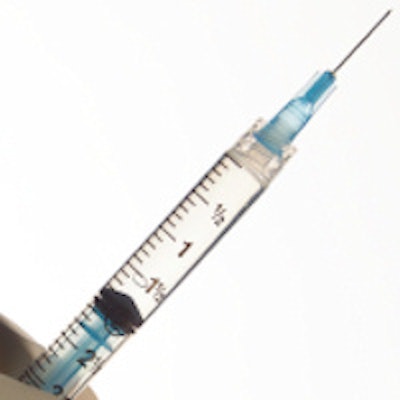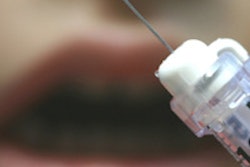
Effective pain management is a crucial part of establishing a strong relationship with a patient during an endodontic procedure, and now a new study recommends a supplement in case the most commonly used inferior alveolar nerve block is not effective.
The inferior alveolar nerve block is the most frequently used nerve block technique for anesthetizing mandibular teeth during endodontic procedures, but it is not always successful in cases of symptomatic irreversible pulpitis, noted the study authors, who are associated with the department of conservative dentistry and endodontics at the Regional Dental College in Assam, India.
They reported that the X-Tip intraosseous anesthesia delivery system (Dentsply) using 4% articaine with 1:100,000 adrenaline was successful in achieving pulpal anesthesia when the inferior alveolar nerve block was ineffective (Journal of Conservative Dentistry, November/December 2014, Vol. 17:6, pp. 522-525).
"The success rate of mandibular anesthesia with the inferior alveolar nerve block has been reported to vary from 38% to 85%," they wrote. "Previous studies have shown success rates of only 19% to 56% for inferior alveolar nerve blocks in patients with irreversible pulpitis."
The X-Tip intraosseous injection allows the deposition of a local anesthetic solution directly into the cancellous bone adjacent to the tooth to be anesthetized. The success of these injections in patients with irreversible pulpitis has been reported to be 82% to 98%, the authors noted.
"The thickness of the cortical plate of posterior mandibular region condemns the use of infiltration injections," they wrote. "The intraosseous injection overcomes this problem by allowing direct access to the cancellous bone via perforation of the cortical bone."
In their study, the researchers included 30 patients (15 males, 15 females) between the ages of 15 to 53. All participants had a diagnosis of symptomatic irreversible pulpitis of mandibular posterior teeth, which was confirmed by a chief complaint of spontaneous pain or pain at night. Cold test and electric pulp testing showed an elevated and lingering pain response. In all 30 patients, control teeth showed normal response, and the inflamed teeth showed an elevated and prolonged pain response to these tests.
The researchers administered the inferior alveolar nerve block injection using 1.7 mL of 4% articaine with 1:100,000 adrenaline using conventional long buccal injection. Patients were asked to rate their pain during access on a visual analogue scale (VAS) that consisted of four categories. No pain corresponded to 0 mm. Mild pain was defined as between 0 mm and 54 mm. Mild pain included the descriptors of faint, weak, and mild pain. Moderate pain was defined as greater than 54 mm and less than 114 mm. Severe pain was defined as 114 mm or more.
"If the patient had moderate to severe pain (VAS rating greater than 54 mm) during access or initial instrumentation, the X-Tip technique was considered as a failure and an intrapulpal injection was administered," the authors noted.
Of the 30 patients who participated in the study, 25 patients (83.33%) experienced no pain or mild pain, and the X-Tip injections were counted as successful. Five patients (16.66%) experienced moderate to severe pain during access or initial instrumentation after intraosseous injections, and these injections were considered failures. None of the X-Tip perforators broke and the onset of anesthesia was immediate.
"When the inferior alveolar nerve block fails to provide adequate pulpal anesthesia, X-Tip system using 4% articaine with 1:100,000 adrenaline was successful in achieving pulpal anesthesia in patients with irreversible pulpitis," the authors concluded. "Supplemental intraosseous injection ... enabled soothing, swift, and sound anesthesia."
Another recent study in the same journal looked at intraosseous injection as an adjunct to conventional local anesthetic techniques (September/October 2014, Vol. 17:5, pp. 432-5). The researchers found that that supplemental intraosseous injection using 4% articaine with 1:100,000 epinephrine had a statistically significant influence in achieving pulpal anesthesia in patients with irreversible pulpitis.
Meanwhile, a 2013 study in Dental Research Journal (March 2013, Vol. 10:2, pp. 210-213) compared the efficacy of X-Tip intraosseous injection and an inferior alveolar nerve block. Considering the relatively expensive armamentarium, the probability of penetrator separation, temporary tachycardia, and the possibility of damage to the root during drilling, intraosseous injection was not a suitable primary technique, the researchers concluded.
Finally, a 2008 Web-based survey of 833 active members of the American Association of Endodontists investigated the use of supplemental intraosseous anesthesia among endodontists in the U.S. (Journal of Endodontics, January 2009, Vol. 35:1, pp. 15-18). "Although more than half of the respondents use some form of intraosseous anesthesia more than twice a week, newer intraosseous anesthesia delivery systems such as Stabident [Fairfax Dental] and X-Tip are used less often than the periodontal ligament injection," the authors of that study concluded.



















